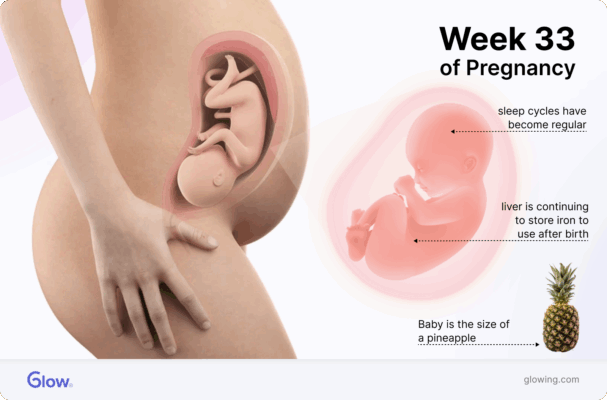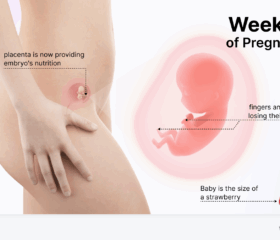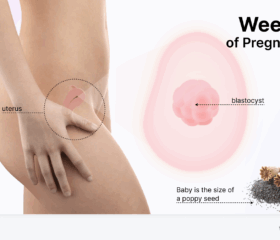Pregnancy Week by Week
33 Weeks Pregnant
Your baby is as big as a pinapple.
17.22
inches
4.23
pounds
33 Weeks Pregnant: Milestones and Tips as You Near the Finish Line
Reaching 33 weeks of pregnancy is a big milestone. You’re probably feeling a mix of excitement, anticipation, and maybe a bit of discomfort. Let’s explore what’s happening with you and your baby as you navigate this stage of pregnancy.
Your baby's development at 33 weeks
At 33 weeks pregnant, your baby is roughly the size of a pineapple (although mercifully, he’s much less spiky). He measures about 17.2 inches long and weighs over 4 pounds. 1 He’s continuing to pack on the pounds, gaining around half a pound each week.
Here’s what else is happening with your little one:
- Brain development: Your baby’s brain and nervous system are now developed enough to control his main bodily functions (to an extent—he still needs some help with breathing, feeding, and temperature control). His brain is showing electrical activity in the sensory parts of the cerebral cortex, although this area won’t fully mature until he reaches his mid-twenties. 2 3
- Skull flexibility: The bones in your baby’s skull aren’t fused yet. This allows them to move slightly and overlap, making it easier for him to pass through the birth canal. These bones will gradually fuse in early adulthood as his brain continues to grow. 45
- Sleep cycle: Your baby’s sleep cycles should be more regular now. He spends most of his time sleeping. 6
- Iron storage: Your baby’s liver is building up its iron stores, which he needs to carry oxygen through his blood. Since breast milk is low in iron, he’ll rely on these stores until he starts eating solids. 2
- Movement: While your baby might not be doing as many somersaults as he used to, you should still feel his movements consistently. His kicks may be sharper now as he gets bigger and space becomes tighter in your womb. You might even feel jabs in new places, like under your ribs.
Your baby’s position at 33 weeks
By now, your baby may have settled into a head-down position as he gets ready for birth. If your baby is in the breech position (feet down), try not to worry—many babies will turn on their own in the coming weeks.
However, certain factors (e.g., the shape of your uterus) could cause your baby to be in the breech position when you go into labor, in which case you’ll need a C-section.
Talk to your doctor if you’re at all concerned about this and want to understand the process more. 7
Counting your baby’s kicks
Now’s a good time to get familiar with your baby’s movement patterns and monitor them by doing regular “kick counts.” Ideally, you should have started doing kick counts in week 28 of your pregnancy.
Choose a time of day when he’s active, and count how long it takes to feel 10 distinct movements. If you don’t feel 10 within 1 hour, wait and try again.
Call your doctor if you still don’t feel at least 10 movements within 1 hour. 8

Your body at 33 weeks
Just as your baby continues to change, so does your body. You may notice new developments this week, such as:
- Swollen labia: Increased blood flow and pressure from your growing uterus can cause swelling and varicose veins to appear in the labia, which may be uncomfortable, itchy, and sore. 9
- Nail changes: Your nails may grow faster. They might also become brittle due to your pregnancy hormones, which are still surging. 10
- Center of gravity: Your center of gravity is still shifting forward, which, coupled with your larger belly, may make you clumsier. 11
Your other symptoms at 33 weeks
As you progress through the third trimester, you may still have to contend with a mix of old and new pregnancy symptoms. Here are a few common ones you might encounter at 33 weeks:
- Trouble sleeping: You might find it hard to get into a comfortable sleeping position, which can lead to pregnancy insomnia. Physical discomfort from your symptoms, alongside anxiety and frequent bathroom trips, may also contribute, making getting a good night’s sleep tricky.
- Aches and pains: Swelling in your hands and wrists may lead to carpal tunnel syndrome, causing achiness, numbness, and tingling. You might also feel aches in your belly when you change positions due to your stretching ligaments.
- Frequent urination: The pressure of your growing uterus on your bladder results in constantly needing to pee, especially at night. As inconvenient as this is, it’s normal.
- Shortness of breath: You might feel short of breath due to your uterus pushing against your diaphragm and lungs. While mild to moderate shortness of breath is typical, discuss it with your doctor if it gets really bad.
- Pregnancy brain: If you’re feeling forgetful or fuzzy-headed, you’re not alone. “Pregnancy brain” is a real symptom, and it’s quite common due to stress, fatigue, and the general mental load of pregnancy, as well as (temporary) hormone-driven changes in your actual gray matter.
- Overheating: You may find yourself feeling unusually hot. That’s probably because of hormonal shifts in your body, as well as your increased blood flow, weight changes, and your boosted metabolism. 12
- Headaches: Your hormonal fluctuations, stress, insomnia, and dehydration can cause you to suffer from headaches.
- Braxton Hicks contractions: There’s a good chance you’ve already started getting these practice contractions, which are typically painless and will disappear when you change positions. They’re different from true labor contractions, which become more intense and regular over time.
You might find it helpful to note down your symptoms using a pregnancy tracker app, in case any new ones warrant a trip to the doctor (more on this below). Some of the best pregnancy trackers also offer tips on how to manage your logged symptoms.
Symptoms to watch out for
While most symptoms in week 33 are normal, a few can indicate complications. Here’s what to watch out for:
Signs of preterm labor
If you go into labor before week 37, it’s considered preterm. Be on the lookout for signs such as:
- Regular contractions that get stronger and more frequent (every 10 minutes or less)
- Pelvic pressure
- Low back pain
- Abdominal cramps
- Changes in your pregnancy discharge (if you have fluid leaking or significant bleeding)
If you experience these symptoms, contact your doctor immediately. Babies born at 33 weeks can survive if given the proper intensive care, but it’s always better if they reach full term (and if you do go into labor early, you and your baby both need to be under medical supervision). 13
Signs of preeclampsia
Preeclampsia is a condition that causes high blood pressure in pregnant women. It usually shows up after week 20. In rare cases, it can cause serious complications for both you and your baby, so be aware of the telltale signs, such as:
- Sudden and severe swelling of the face, hands, and feet
- Blurry vision, or other big changes to your vision
- Pain (usually right upper quadrant pain, right below the ribs in the front of the body)
- Shortness of breath
Try to stay calm if you notice these symptoms. It could also just be your body’s normal response to pregnancy. Still, it’s better to play it safe and get to a doctor.
How to look after yourself and your baby at 33 weeks
This stage of your pregnancy can be challenging, and it’s only natural if you feel fed up with your symptoms. With that in mind, here are ways you can manage them:
Prioritize rest
Make sure you get as much rest as possible. Take naps during the day when you can, and create a comfortable sleeping environment at night. You can try using light-blocking window coverings, put on relaxing music (white noise can also be effective), and make sure your room is cool.
Eat a balanced diet
As tempting as that whole box of cookies looks, you need to eat well. Include plenty of nutritious foods in your pregnancy diet, especially those containing omega-3 fatty acids (DHA), which are essential for your baby’s brain and vision development. Safe sources of DHA include low-mercury fish such as salmon and also supplements. 14
Lighten up on exercise
While it’s important to stay moderately active, you need to modify your exercise routines to suit your changing body. If you do weight training, ask your doctor how much you can lift while you’re pregnant. Switch to light weights and more reps, as lifting heavy weights can put unnecessary pressure on your body.
Make sure to stop exercising immediately if anything starts to hurt.
Practice self-care
There are plenty of home remedies you can use to ease your symptoms. Try applying a cold compress to the back of your neck to relieve headaches (or to just cool down if you’re overheated).
If you feel anxious, try calming down with breathing exercises or meditation, especially before bed.
If you’re suffering from aches and pains, you could treat yourself to a prenatal massage. Be sure to go to a qualified practitioner—not all masseuses know how to give them safely.
How to prepare for your baby’s arrival
As you approach the end of your pregnancy, there are several things you can do to prepare for your baby’s arrival.
- Stock up on baby essentials: Make sure you have newborn clothes, blankets, and, of course, plenty of diapers. Wash all new clothes before your baby wears them to remove irritants, but avoid detergents with anti-static or fabric-softening properties. 15
- Baby-proof your nursery: Check that his crib and other furniture are anchored, with cords and outlets all out of reach.
- Look into breastfeeding: Assuming you plan on breastfeeding, watch videos or attend a breastfeeding class so that you understand how to actually do it (getting a good latch is easier said than done, but it prevents complications like clogged nipple pores or “milk blebs“).
- Consider room-sharing: Think about whether or not you want to room-share with your baby when he arrives, and check your hospital’s policy. It’s a personal decision whether or not you want to share a room with him at the hospital, but it can be a great way to bond with him. Note that this might not be an option if he is born prematurely and needs to spend time in the neonatal intensive care unit or nursery.
- Narrow down baby names: Here’s another fun (and potentially stressful) task: if you haven’t chosen a name yet, narrow down your list and think about how each potential pick will sound with your last name, as well as the meaning of the name.
Plan your maternity leave
If you haven’t already, discuss your maternity leave plan with your employer and human resources department. You should give them at least 30 days’ notice before you plan to take your leave. Many start taking leave by 36 weeks of pregnancy.
Your HR rep will show you the different options for maternity leave, which may or may not be paid. The Family and Medical Leave Act (FMLA) entitles many employees to 12 weeks of unpaid leave for mothers to take care of their newborns. 16 However, not all companies offer it, so be sure to double-check.
How to prepare for labor and delivery
Your due date is closer than ever! It’s time to sort out your final preparations.
Pack your hospital bag
Go ahead and pack your hospital bag, even though you aren’t due for a few more weeks. You’ll need to include items such as comfortable clothes, toiletries, nursing bras, heavy-duty pads, a going-home outfit for your baby, and your phone charger.
Make sure you leave your bag by the door or in a visible place where you can easily grab it—when labor starts, you’ll need to move fast!
Install your baby’s car seat
Some infant car seats can be a little tricky to install, so make sure you carefully read the manufacturer’s instructions. If you don’t feel totally confident setting it up yourself, that’s fine. Just look for a car seat technician in your area.
Work out your hospital route
Find the quickest and easiest route to the hospital where you’ll deliver your baby. You’ll also need to figure out who’s going to drive you and where to park. Make sure you pick someone you can call at a moment’s notice.
Final thoughts
The third trimester can be challenging, but remember how far you’ve come. You’re closer than ever before to meeting your baby.
Take time to look after yourself, make all the preparations you need, and enjoy your last few weeks. Before long, you’re going to be up to your knees in diapers!
Article Sources
- Baby Your Baby. "Fetal Growth Chart" Retrieved June 30, 2025.
- MedlinePlus. "Fetal development" Retrieved June 30, 2025.
- McMaster Children’s Hospital. "Information for parents of preterm babies at 31 to 34 weeks gestation" Retrieved June 30, 2025.
- University of Illinois Hospital & Health Sciences System. "You and Your Baby: Month-by-Month" Retrieved June 30, 2025.
- National Health Service. "Week 33" Retrieved June 30, 2025.
- News Medical. "Pregnancy: 33 - 36 weeks" Retrieved June 30, 2025.
- Cleveland Clinic. "Breech Baby" Retrieved June 30, 2025.
- Cleveland Clinic. "Kick Counts" Retrieved June 30, 2025.
- Mayo Clinic. "Pregnancy week by week" Retrieved June 30, 2025.
- The Journal of Obstetrics and Gynecology of India. "Pregnancy and Skin" Retrieved June 30, 2025.
- The Permanente Medical Group. "Center of Gravity Changes" Retrieved June 30, 2025.
- North Atlanta Women's Care. "Feeling Hot During Pregnancy? Understanding the Causes and Solutions" Retrieved June 30, 2025.
- Eunice Kennedy Shriver National Institute of Child Health and Human Development. "What are the symptoms of preterm labor?" Retrieved June 30, 2025.
- American Pregnancy Association. "Omega 3 Fatty Acids: FAQs" Retrieved June 30, 2025.
- Nemours KidsHealth. "Laundering Your Baby's Clothes" Retrieved June 30, 2025.
- U.S. Department of Labor. "Family and Medical Leave Act" Retrieved June 30, 2025.







